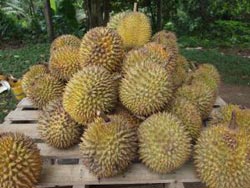Durian (Durio zibethinus L.) shell and Banana Pseudostem Fibers

Copyright : Kalai / CC<br>
This study explored the use of inexpensive materials as alternatives to treat effluents from various industries such as petroleum, metals, food processing, textile, industries as well as municipal waste waters and has become a global environmental issue.
This study explored the use of inexpensive materials as alternatives to treat effluents from various industries such as petroleum, metals, food processing, textile, industries as well as municipal wastewaters and has become a global environmental issue.
These effluents containing oil can cause serious detrimental environmental impact on the receptor water bodies and induces detrimental effects to aquatic life. It also causes serious problems to wastewater treatment plants due to its high stability and it can be separated only with the help of chemical clarification. Batch adsorption study was conducted to evaluate efficiencies of two different agriculture wastes as micro sorbent to remove oil from aqueous solution.
The agriculture waste used in this study was Durian Shell (DS) and Banana Pseudostems (BPS).
Durian shell and Banana Pseudostems are naturally occurring plants found abundantly in Malaysia. The durian fruit is a seasonal fruit which emits a pungent smell and is commonly referred to as the “King of Fruits”. The banana fruit is a non seasonal fruit and is found in abundance in Malaysia. A detailed batch study to determine its adsorption equilibrium, isotherm and kinetics was carried out at ambient temperatures, various initial concentrations of oil and stirring time. Banana pseudostem was found to be more effective than Durian Shell in removing oil from water.
Langmuir and Freundlich adsorption model were applied to describe the experimental isotherm and isotherm constants. The kinetic data was best fitted to the pseudo-second-order kinetic model. The role of DS and BPS in the removal of oil from aqueous wastes was investigated.
The researchers concluded that BPS performed exceptionally well to remove oil from aqueous solution as compared to DS.
Langmuir and Freundlich adsorption model were applied to describe the experimental isotherm and isotherm constants. Equilibrium data fitted well with Freundlich model. Thus it is reasonable to conclude that the adsorption of oil on both adsorbents that consist of heterogeneous adsorption sites are similar to each other in respect of the adsorption phenomenon. Kinetic studies indicated that the sorption of oil tend to follow pseudosecond- order kinetics for the range of studied concentrations.
This study is hoped to give rise to new avenues of exploring the possibility of using inexpensive materials to remove oil from aqueous solution.
Contact Information:
Nurul Izza Husin,
Department of Applied Sciences, UiTM Malaysia.
nurulizza.husin@ppinang.uitm.edu.my
Media Contact
All latest news from the category: Agricultural and Forestry Science
Newest articles

High-energy-density aqueous battery based on halogen multi-electron transfer
Traditional non-aqueous lithium-ion batteries have a high energy density, but their safety is compromised due to the flammable organic electrolytes they utilize. Aqueous batteries use water as the solvent for…

First-ever combined heart pump and pig kidney transplant
…gives new hope to patient with terminal illness. Surgeons at NYU Langone Health performed the first-ever combined mechanical heart pump and gene-edited pig kidney transplant surgery in a 54-year-old woman…

Biophysics: Testing how well biomarkers work
LMU researchers have developed a method to determine how reliably target proteins can be labeled using super-resolution fluorescence microscopy. Modern microscopy techniques make it possible to examine the inner workings…





















